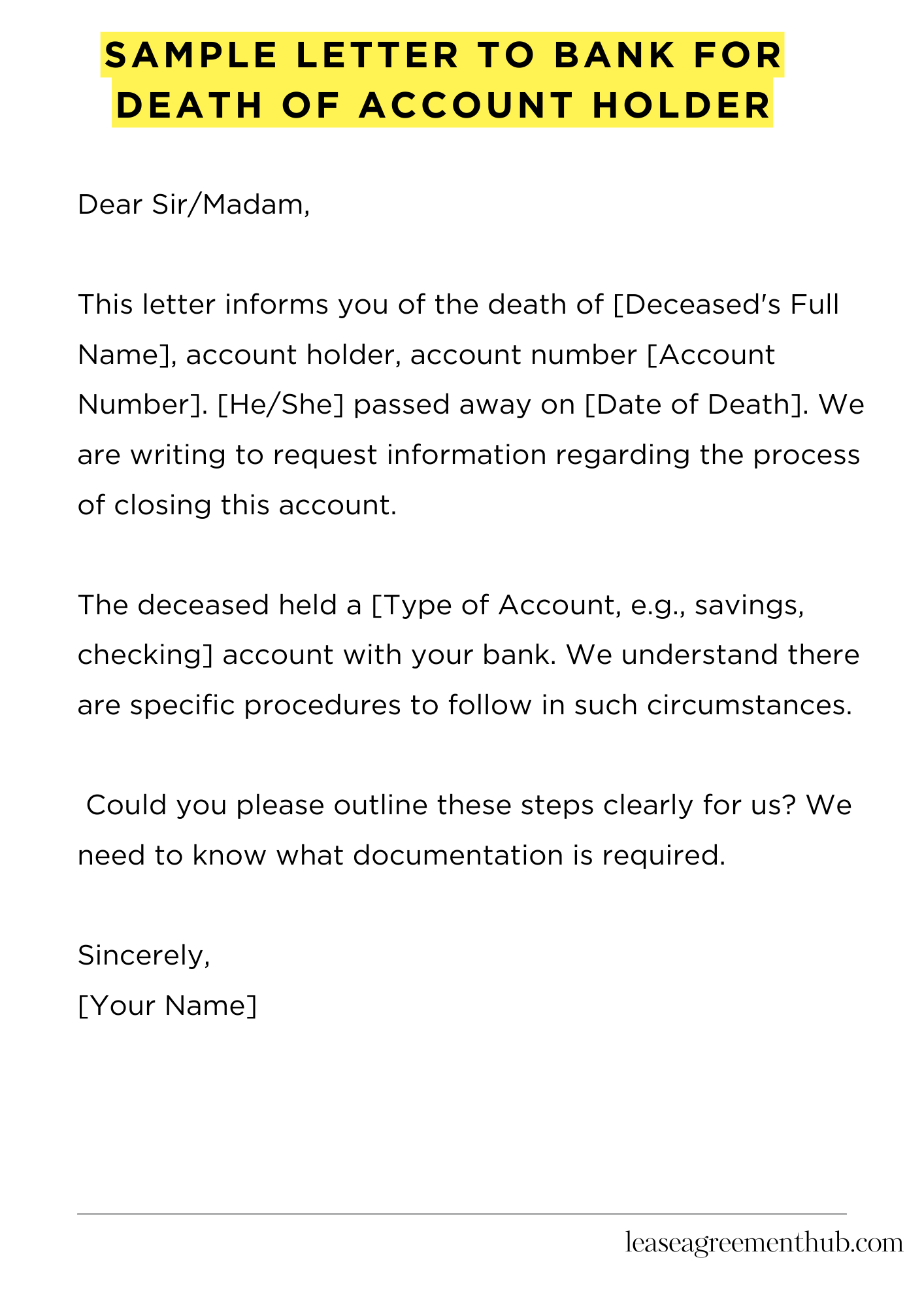Losing a loved one is difficult. Handling their finances afterward is even harder. A letter to the bank is a crucial first step.
This article provides sample letters. These are templates to help you. They make writing your own letter easier.
Use these samples as a guide. Adapt them to your situation. Get the closure you need quickly.
Sample Letter to Bank for Death of Account Holder
[Your Name]
[Your Address]
[Your Phone Number]
[Your Email Address]
[Date]
[Bank Name]
[Bank Address]
Dear Sir/Madam,
This letter informs you of the death of [Deceased’s Full Name], account holder, account number [Account Number]. [He/She] passed away on [Date of Death]. We are writing to request information regarding the process of closing this account.
The deceased held a [Type of Account, e.g., savings, checking] account with your bank. We understand there are specific procedures to follow in such circumstances. Could you please outline these steps clearly for us? We need to know what documentation is required.
We are the legal beneficiaries named in [Deceased’s Will/Other Legal Document, e.g., Power of Attorney]. A copy of this document is attached for your review. We are prepared to provide any further documentation you may require. Please let us know what the next steps are to ensure a smooth and efficient closure of the account. We anticipate needing to access the funds within the account.
We look forward to your prompt response and guidance on this matter. Please contact us at your earliest convenience. Thank you for your time and assistance during this difficult time.
Sincerely,
[Your Name]

How to Write a Sample Letter to Bank for Death of Account Holder
Understanding the Nuances of Death Notifications
Informing a bank of an account holder’s demise requires a delicate approach. Legally, notification is crucial to prevent fraudulent activity and initiate the probate process. This isn’t a simple task; it demands precision and adherence to specific protocols. Failure to follow proper procedure can lead to significant delays and complications.
Gathering Essential Documentation: A Proactive Approach
Before composing your letter, assemble all necessary documentation. This includes the deceased’s death certificate – a sine qua non for any such transaction. Furthermore, you’ll need proof of your relationship to the deceased, such as a birth certificate or will. Providing comprehensive documentation streamlines the process considerably. Don’t underestimate the importance of meticulous preparation.
Structuring Your Letter for Maximum Efficacy
A well-structured letter is paramount. Begin with a formal salutation addressing the bank’s relevant department, perhaps the “Estate Administration Division.” Clearly state the purpose of your letter in the opening paragraph. Concisely present the details of the deceased’s account, including the account number and type. A clear and unambiguous presentation is essential.
Crafting the Body: Clarity and Conciseness
The body of your letter should contain the deceased’s full name, date of death, and account details. Include your own contact information, ensuring it’s easily accessible. Mention your relationship to the deceased and the reason for contacting the bank. A cogent and well-organized letter shows respect for the process and the deceased.
Addressing the Legal Ramifications
Mention any legal proceedings, such as probate, that are underway or anticipated. This crucial element informs the bank of the legal framework governing the account’s future. Clearly state whether you are acting as executor, administrator, or beneficiary. Legal precision protects both yourself and the bank.
Concluding With a Formal Closing and Contact Information
Conclude with a formal closing, such as “Sincerely,” followed by your typed name. Reiterate your contact information for easy communication. Include your phone number and email address. Ensure the letter is professional and legible. A polished letter reflects well on you and the deceased’s legacy.
Sample Letter and Final Considerations
While a sample letter can provide a template, remember to personalize it with the specific details of the situation. Each case is unique, necessitating a tailored approach. Consider seeking legal counsel if you face complex situations or uncertainties. Remember, accuracy and meticulous attention to detail are crucial steps in navigating this sensitive matter.
FAQs about sample letter to bank for death of account holder
Losing a loved one is a difficult time, and dealing with their financial affairs can add to the stress. Knowing what information to include in a letter to the bank about the death of an account holder is crucial for a smooth process.
What information about the deceased account holder should be included in the letter?
The letter should clearly state the death of the account holder and provide their full legal name, date of birth, account number(s), and the date of death. Including the deceased’s address as it appears on the bank records is also important.
Who should write the letter to the bank?
The letter should be written by a legal heir or executor of the will. This person should clearly state their relationship to the deceased and provide proof of their authority to handle the account, such as a copy of the will or death certificate.
What should I request from the bank in my letter?
The letter should clearly state the desired action. This may include requesting information on account balances, instructions for transferring funds, closing the account, or obtaining details on the process of probate.
What supporting documents should accompany the letter?
Supporting documents are crucial for verifying the information provided. These should include a copy of the death certificate, a copy of the deceased’s will (if applicable), and proof of the writer’s identity and relationship to the deceased. Additional documents might be requested by the bank based on the specific circumstances.
What is the best way to send the letter to the bank?
While some banks accept electronic correspondence, it’s generally recommended to send the letter via certified mail with return receipt requested. This provides proof of delivery and helps ensure the bank receives the notification. Always keep a copy of the letter and all supporting documents for your records.
Related: